Submitted:
27 March 2024
Posted:
29 March 2024
You are already at the latest version
Abstract
Keywords:
1. Introduction
2. Preliminaries
3. Statistical Aging in Mixed Renewal Processes
4. Analysis of Exchangeable Event Sequences: Simulations and Empirical Results
4.1. Exchangeable Mixture Models
4.1.1. Mixture of Exponentials
-
At this point we will switch our analysis to an exchangeable sequence, which follows an exponential distribution with a rate that is a uniform random variable, i.e., with the rate undergoing to . The marginal density function of the waiting times is given by the unconditional mixed-type pdf as from eq.(12):The equation above is valid since the conditional aged probability density function can be written as so that the conditional aged pdf is equal to the non-aged one:Essentially, in this example case the renewal process is affected by neutral aging. Moreover, the mixed renewal function can be written in terms of the laplace transform as from proposition 4:so the mean rate of events is:so that the average number of renewals increases linearly with time even in presence of aging since it is independend from the latency period .Moreover, as regarding the hazard rate, we have:so that the hazard rate is a decreasing function, which is different from its conditional hazard counterpart which is constant. Finally, the asymptotic mean residual lifetime is .as expected. In Figure 2 we compare tha analytical results with simulations in the case of . plot the marginal distribution of which follows a fat-tail distribution function with an asymptotic behavior of .
-
As a more general example, let assume again but now the exponential rate follows a gamma distribution i.e., , where is the shape factor and is the scale factor. So, in this case, the marginal density function of the waiting times is given by the unconditional mixed-type pdf:which is is a Pareto Lomax density function. So, even in this case, the process shows a neutral aging since there is no dependence on the latency period . In addition, it is straightforward to see that the unconditional hazard function is:Consequently, the cumulative hazard rate is . Similarly, one can find that the mean residual lifetime asymptotic behavior is . Finally, the mixed renewal function can be written as:so the average number of renewals is:which increases linearly with time even in presence of aging as in the previous example.Essentially, all the survival analysis is quite similar to the one in previous example.
4.1.2. Mixture of Generalized Exponentials
4.1.3. Mixture of Heavy-Tail Distributions
4.2. Case Study: High Frequency Exchange Rates
5. Concluding Remarks
Author Contributions
Funding
Data Availability Statement
Acknowledgments
Conflicts of Interest
Abbreviations
| CDF | Cumulative Distribution Function |
| eCDF | empirical Cumulative Distribution Function |
| probability density function | |
| i.i.d. | independent identically distributed |
| DP | Dirichlet Process |
| EXP | Exponential |
| GA | Gamma |
| ML | Mittag-Leffler |
Appendix A. Mixture Models Derivations
Appendix A.1. Derivation of eq.(uid48):
Appendix Derivation of eq.(uid50):
Appendix Derivation of eq.(uid57):
Appendix Derivation of eq.(uid58):
References
- Feller, W. An introduction to probability theory and its applications; Vol. 1, John Wiley & Sons, 1968.
- Feller, W. An introduction to probability theory and its applications; Vol. 2, John Wiley & Sons, 1991.
- Cox, D.R. Renewal theory; Vol. 1, Methuen London, 1967.
- Barlow, R.E.; Proschan, F. Statistical theory of reliability and life testing: Probability models; Vol. 1, Holt, Rinehart and Winston New York, 1975.
- Lio, Y.; Chen, D.G.; Ng, H.T.; Tsai, T.R. Bayesian Inference and Computation in Reliability and Survival Analysis; Springer, 2022.
- Mitov, K. Renewal processes; Springer: Cham, 2014. [Google Scholar]
- Cha, J.H.; Finkelstein, M. ; others. Point processes for reliability analysis, 2018. [Google Scholar]
- De Finetti, B. Funzione caratteristica di un fenomeno aleatorio. Atti del Congresso Internazionale dei Matematici: Bologna del 3 al 10 de settembre di 1928, 1929, pp. 179–190. [Google Scholar]
- De Finetti, B. La prévision: Ses lois logiques, ses sources subjectives. Annales de l’institut Henri Poincaré 1937, 7, 1–68. [Google Scholar]
- Aldous, D.J. Exchangeability and related topics. In École d’Été de Probabilités de Saint-Flour XIII—1983; Springer, 1985; pp. 1–198.
- Bernardo, J.M.; Smith, A.F. Bayesian theory; Vol. 405, John Wiley & Sons, 2009.
- Coen, A.; Gutiérrez, L.; Mena, R.H. Modelling failures times with dependent renewal type models via exchangeability. Statistics 2019, 53, 1112–1130. [Google Scholar] [CrossRef]
- Huang, W.J. On the characterization of point processes with the exchangeable and Markov properties. Sankhyā: The Indian Journal of Statistics, Series A.
- Lyberopoulos, D.P.; Macheras, N.D. Some characterizations of mixed renewal processes. Mathematica Slovaca 2022, 72, 197–216. [Google Scholar] [CrossRef]
- Metzler, R.; Jeon, J.H.; Cherstvy, A.G.; Barkai, E. Anomalous diffusion models and their properties: Non-stationarity, non-ergodicity, and ageing at the centenary of single particle tracking. Physical Chemistry Chemical Physics 2014, 16, 24128–24164. [Google Scholar] [CrossRef] [PubMed]
- Bianco, S.; Grigolini, P.; Paradisi, P. Fluorescence intermittency in blinking quantum dots: Renewal or slow modulation? The Journal of chemical physics 2005, 123. [Google Scholar] [CrossRef] [PubMed]
- Laloux, L.; Le Doussal, P. Aging and diffusion in low dimensional environments. Physical Review E 1998, 57, 6296. [Google Scholar] [CrossRef]
- Godreche, C.; Luck, J. Statistics of the occupation time of renewal processes. Journal of Statistical Physics 2001, 104, 489–524. [Google Scholar] [CrossRef]
- Monthus, C.; Bouchaud, J.P. Models of traps and glass phenomenology. Journal of Physics A: Mathematical and General 1996, 29, 3847. [Google Scholar] [CrossRef]
- Parisi, G. Short-time aging in binary glasses. Journal of Physics A: Mathematical and General 1997, 30, L765. [Google Scholar] [CrossRef]
- Baity-Jesi, M.; Calore, E.; Cruz, A.; Fernandez, L.; Gil-Narvion, J.; Gonzalez-Adalid Pemartin, I.; Gordillo-Guerrero, A.; Iñiguez, D.; Maiorano, A.; Marinari, E. ; others. Memory and rejuvenation effects in spin glasses are governed by more than one length scale. Nature Physics.
- Böhmer, T.; Gabriel, J.P.; Costigliola, L.; Kociok, J.N.; Hecksher, T.; Dyre, J.C.; Blochowicz, T. Time reversibility during the ageing of materials. Nature Physics.
- Barkai, E. Aging in subdiffusion generated by a deterministic dynamical system. Physical review letters 2003, 90, 104101. [Google Scholar] [CrossRef] [PubMed]
- Akimoto, T.; Barkai, E. Aging generates regular motions in weakly chaotic systems. Physical Review E 2013, 87, 032915. [Google Scholar] [CrossRef]
- Gupta, A.K.; Zeng, W.B.; Wu, Y. Probability and statistical models: Foundations for problems in reliability and financial mathematics; Springer Science & Business Media, 2010.
- Hens, T.; Schenk-Hoppé, K.R. Handbook of financial markets: Dynamics and evolution; Elsevier, 2009.
- Barbiero, A.; Hitaj, A. Discrete half-logistic distributions with applications in reliability and risk analysis. Annals of Operations Research.
- Bianco, S.; Grigolini, P. Aging in financial market. Chaos, Solitons & Fractals 2007, 34, 41–50. [Google Scholar]
- Fama, E.F. The behavior of stock-market prices. The journal of Business 1965, 38, 34–105. [Google Scholar] [CrossRef]
- Cherstvy, A.G.; Vinod, D.; Aghion, E.; Chechkin, A.V.; Metzler, R. Time averaging, ageing and delay analysis of financial time series. New journal of physics 2017, 19, 063045. [Google Scholar] [CrossRef]
- Niepert, M.; Domingos, P. Exchangeable variable models. International Conference on Machine Learning, 2014, pp. 271–279.
- Poirier, D.J. 40 Exchangeability, Representation Theorems, and Subjectivity. In The Oxford Handbook of Bayesian Econometrics; Oxford University Press, 2011; [https://academic.oup.com/book/0/chapter/334662922/chapter-ag-pdf/44445457/book_38595_section_334662922.ag.pdf]. [CrossRef]
- Hewitt, E.; Savage, L.J. Symmetric measures on Cartesian products. Transactions of the American Mathematical Society 1955, 80, 470–501. [Google Scholar] [CrossRef]
- Diaconis, P.; Freedman, D. Finite exchangeable sequences. The Annals of Probability.
- Kerns, G.J.; Székely, G.J. Definetti’s theorem for abstract finite exchangeable sequences. Journal of Theoretical Probability 2006, 19, 589–608. [Google Scholar] [CrossRef]
- Kallenberg, O. Probabilistic Symmetries and Invariance Principles; Springer New York: New York, NY, 2005. [Google Scholar]
- O’Neill, B. Exchangeability, correlation, and Bayes’ effect. International statistical review 2009, 77, 241–250. [Google Scholar] [CrossRef]
- Barber, R.F.; Candes, E.J.; Ramdas, A.; Tibshirani, R.J. De Finetti’s Theorem and Related Results for Infinite Weighted Exchangeable Sequences. arXiv preprint arXiv:2304.03927, arXiv:2304.03927 2023.
- Zabell, S.L. Predicting the unpredictable. Synthese 1992, 90, 205–232. [Google Scholar] [CrossRef]
- Bernardo, J.M. Bayesian statistics. Probability and Statistics, R. Viertl, Ed 1994, 2, 345–407. [Google Scholar]
- Bernardo, J.M. The concept of exchangeability and its applications. Far East Journal of Mathematical Sciences 1996, 4, 111–122. [Google Scholar]
- Brokmann, X.; Hermier, J.P.; Messin, G.; Desbiolles, P.; Bouchaud, J.P.; Dahan, M. Statistical aging and nonergodicity in the fluorescence of single nanocrystals. Physical review letters 2003, 90, 120601. [Google Scholar] [CrossRef] [PubMed]
- Allegrini, P.; Barbi, F.; Grigolini, P.; Paradisi, P. Renewal, modulation, and superstatistics in times series. Physical Review E 2006, 73, 046136. [Google Scholar] [CrossRef] [PubMed]
- Paradisi, P.; Grigolini, P.; Bianco, S.; Akin, O.C. Renewal aging in non-homogeneous poisson processes with periodic rate modulation. International Journal of Bifurcation and Chaos 2008, 18, 2681–2691. [Google Scholar] [CrossRef]
- Aquino, G.; Bologna, M.; Grigolini, P.; West, B.J. Aging and rejuvenation with fractional derivatives. Physical Review E 2004, 70, 036105. [Google Scholar] [CrossRef] [PubMed]
- Allegrini, P.; Aquino, G.; Grigolini, P.; Palatella, L.; Rosa, A.; West, B.J. Correlation function and generalized master equation of arbitrary age. Physical Review E 2005, 71, 066109. [Google Scholar] [CrossRef] [PubMed]
- Bernstein, D.L. The double Laplace integral. Duke Mathematical Journal 1941, 8(3), 460–496. [Google Scholar] [CrossRef]
- Debnath, L.; Bhatta, D. Integral transforms and their applications; Chapman and Hall/CRC, 2016; chapter 4.
- Aquino, G.; Palatella, L.; Grigolini, P. Absorption and emission in the non-poisson case: The theoretical challenge posed by renewal aging. Brazilian journal of physics 2005, 35, 418–424. [Google Scholar] [CrossRef]
- Spizzichino, F. Subjective probability models for lifetimes; CRC Press, 2001.
- Lai, C.D.; Xie, M. Stochastic ageing and dependence for reliability; Springer Science & Business Media, 2006.
- Nappo, G.; Spizzichino, F. Relations between ageing and dependence for exchangeable lifetimes with an extension for the IFRA/DFRA property. Dependence Modeling 2020, 8, 1–33. [Google Scholar] [CrossRef]
- McCall, J.J. ; others. An introduction to exchangeability and its economic applications, 1988. [Google Scholar]
- Faragó, A. Decomposition of Random Sequences into Mixtures of Simpler Ones and Its Application in Network Analysis. Algorithms 2021, 14, 336. [Google Scholar] [CrossRef]
- Mainardi, F.; Gorenflo, R.; Vivoli, A. Renewal Processes of Mittag-Leffler and Wright Type. Fractional Calculus and Applied Analysis 2005, 8, 07–38. [Google Scholar]
- Mainardi, F.; Raberto, M.; Gorenflo, R.; Scalas, E. Fractional calculus and continuous-time finance II: The waiting-time distribution. Physica A: Statistical Mechanics and its Applications 2000, 287, 468–481. [Google Scholar] [CrossRef]
- Pramukkul, P.; Svenkeson, A.; Grigolini, P.; Bologna, M.; West, B.; others. Complexity and the fractional calculus. Advances in Mathematical Physics 2013, 2013. [Google Scholar] [CrossRef]
- Apelblat, A. Differentiation of the Mittag-Leffler functions with respect to parameters in the Laplace transform approach. Mathematics 2020, 8, 657. [Google Scholar] [CrossRef]
- Gorenflo, R.; Kilbas, A.A.; Mainardi, F.; Rogosin, S.V. ; others. Mittag-Leffler functions, related topics and applications, 2020. [Google Scholar]
- Scalas, E.; Gorenflo, R.; Mainardi, F. Fractional calculus and continuous-time finance. Physica A: Statistical Mechanics and its Applications 2000, 284, 376–384. [Google Scholar] [CrossRef]
- Gençay, R.; Dacorogna, M.; Muller, U.A.; Pictet, O.; Olsen, R. An introduction to high-frequency finance; Elsevier, 2001.
- Palatella, L.; Perelló, J.; Montero, M.; Masoliver, J. Activity autocorrelation in financial markets: A comparative study between several models. The European Physical Journal B-Condensed Matter and Complex Systems 2004, 38, 671–677. [Google Scholar] [CrossRef]
- Taylor, S.J. Modeling stochastic volatility: A review and comparative study. Mathematical finance 1994, 4, 183–204. [Google Scholar] [CrossRef]
- Pederzoli, C. Stochastic volatility and GARCH: A comparison based on UK stock data. European Journal of Finance 2006, 12, 41–59. [Google Scholar] [CrossRef]
- Fouque, J.P.; Papanicolaou, G.; Sircar, K.R. Derivatives in financial markets with stochastic volatility; Cambridge University Press, 2000.
- Cont, R. Statistical modeling of high-frequency financial data. IEEE Signal Processing Magazine 2011, 28, 16–25. [Google Scholar] [CrossRef]
- Corp., I.D. Corp., I.D. TrueFX Market exchange rate data, 2014. EURUSD exchange rates data retrieved for november 2022 from https://www.truefx.com/truefx-historical-downloads/#93-106-november.
- Scalas 7, E.; Gorenflo, R.; Luckock, H.; Mainardi, F.; Mantelli, M.; Raberto, M. Anomalous waiting times in high-frequency financial data. Quantitative Finance 2004, 4, 695–702. [Google Scholar] [CrossRef]
- Aldrich, E.M.; Heckenbach, I.; Laughlin, G. The random walk of high frequency trading. arXiv preprint arXiv:1408.3650, arXiv:1408.3650 2014.
- Gao, F.; He, X. Survival Analysis: Theory and Application in Finance. In HANDBOOK OF FINANCIAL ECONOMETRICS, MATHEMATICS, STATISTICS, AND MACHINE LEARNING; World Scientific, 2021; pp. 4087–4118.
- Gepp, A.; Kumar, K. The role of survival analysis in financial distress prediction. International research journal of finance and economics 2008, 16, 13–34. [Google Scholar]
- Beck, C. Superstatistics: Theory and applications. Continuum mechanics and thermodynamics 2004, 16, 293–304. [Google Scholar] [CrossRef]
- Uchiyama, Y.; Kadoya, T. Superstatistics with cut-off tails for financial time series. Physica A: Statistical Mechanics and its Applications 2019, 526, 120930. [Google Scholar] [CrossRef]
- Schäfer, B.; Heppell, C.M.; Rhys, H.; Beck, C. Fluctuations of water quality time series in rivers follow superstatistics. Iscience 2021, 24. [Google Scholar] [CrossRef] [PubMed]
- Katz, Y.A.; Tian, L. Superstatistical fluctuations in time series of leverage returns. Physica A: Statistical Mechanics and its Applications 2014, 405, 326–331. [Google Scholar] [CrossRef]
- Beck, C. Recent developments in superstatistics. Brazilian Journal of Physics 2009, 39, 357–363. [Google Scholar] [CrossRef]
- Tobias, P.A.; Trindade, D. Applied reliability; CRC Press, 2011.
- Wang, P.; Coit, D.W. Repairable systems reliability trend tests and evaluation. Proceedings of the Annual Reliability and Maintainability Symposium. Citeseer, 2005, pp. 416–421.
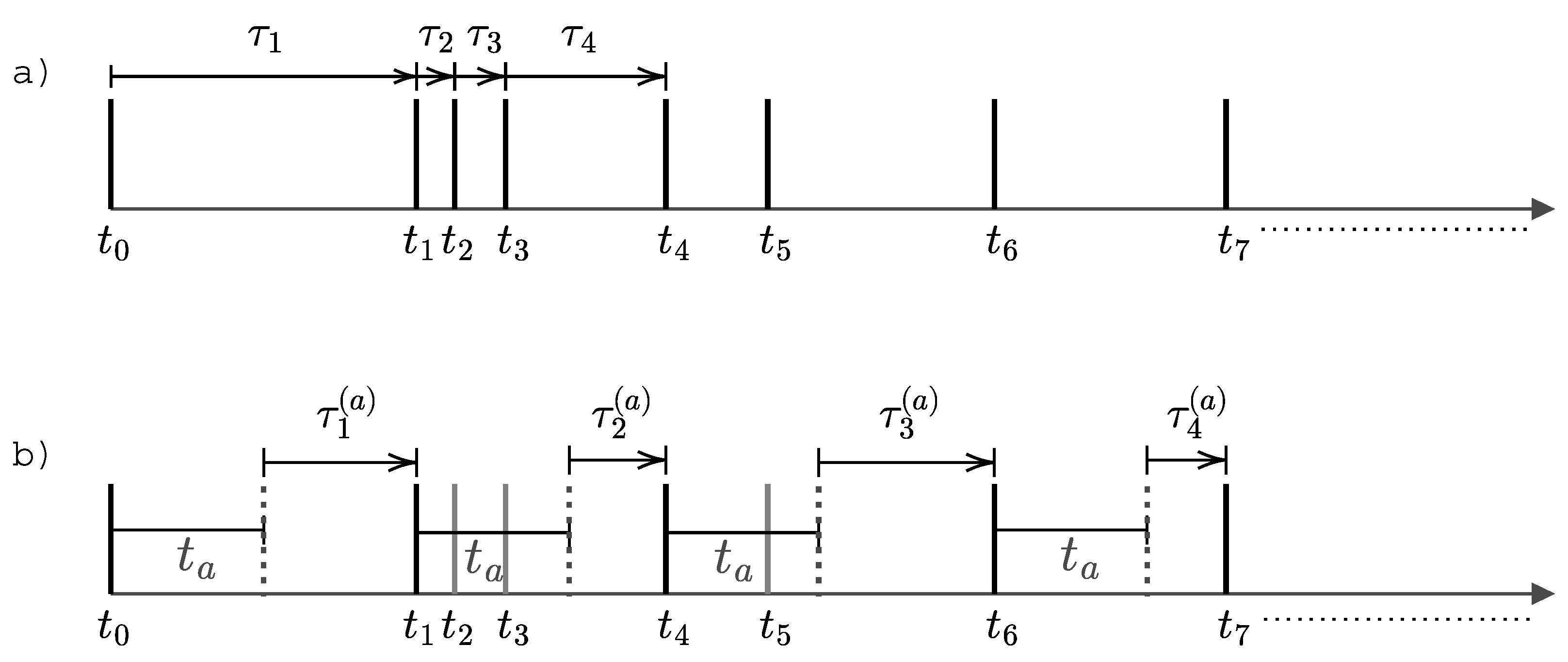

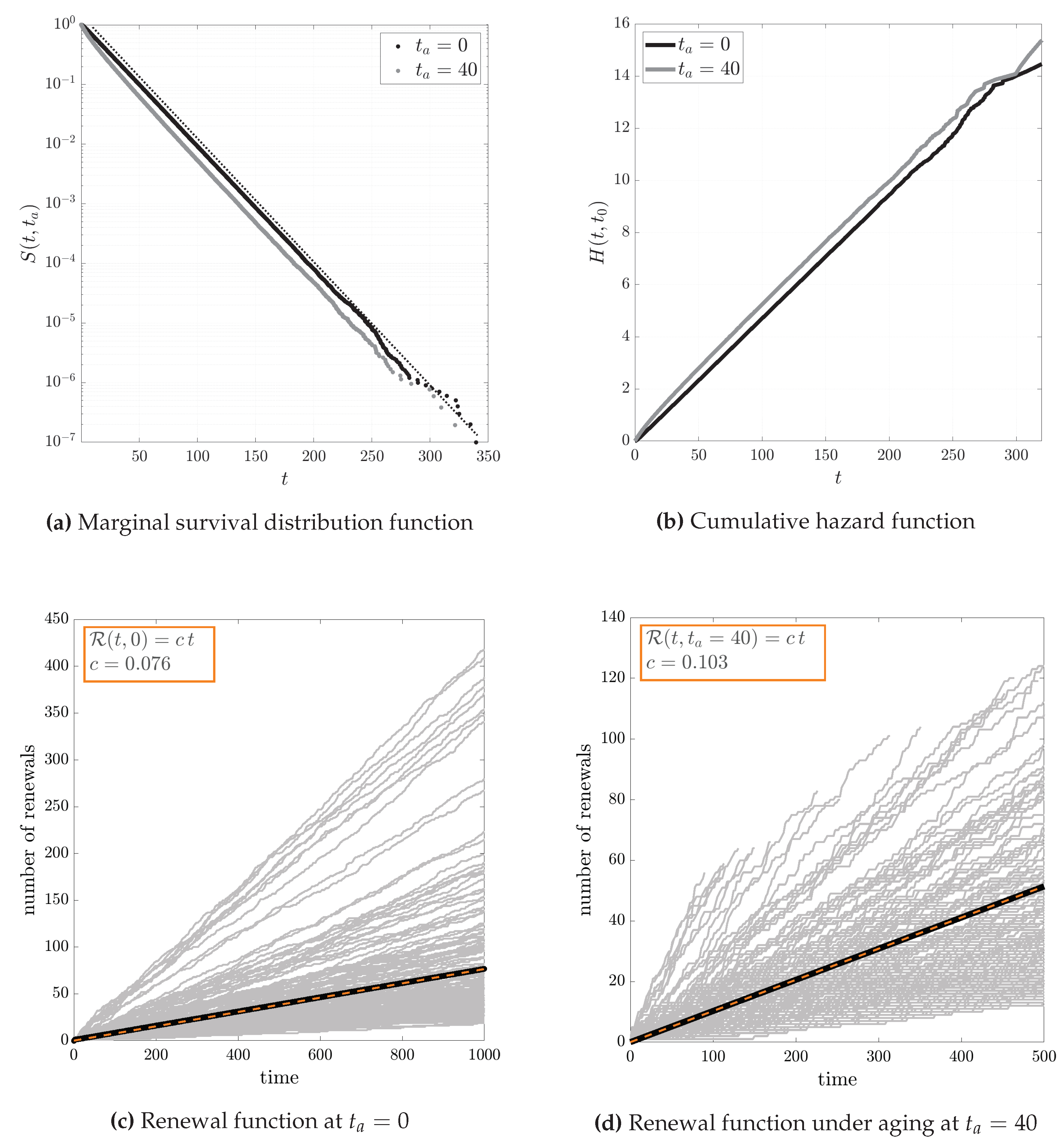
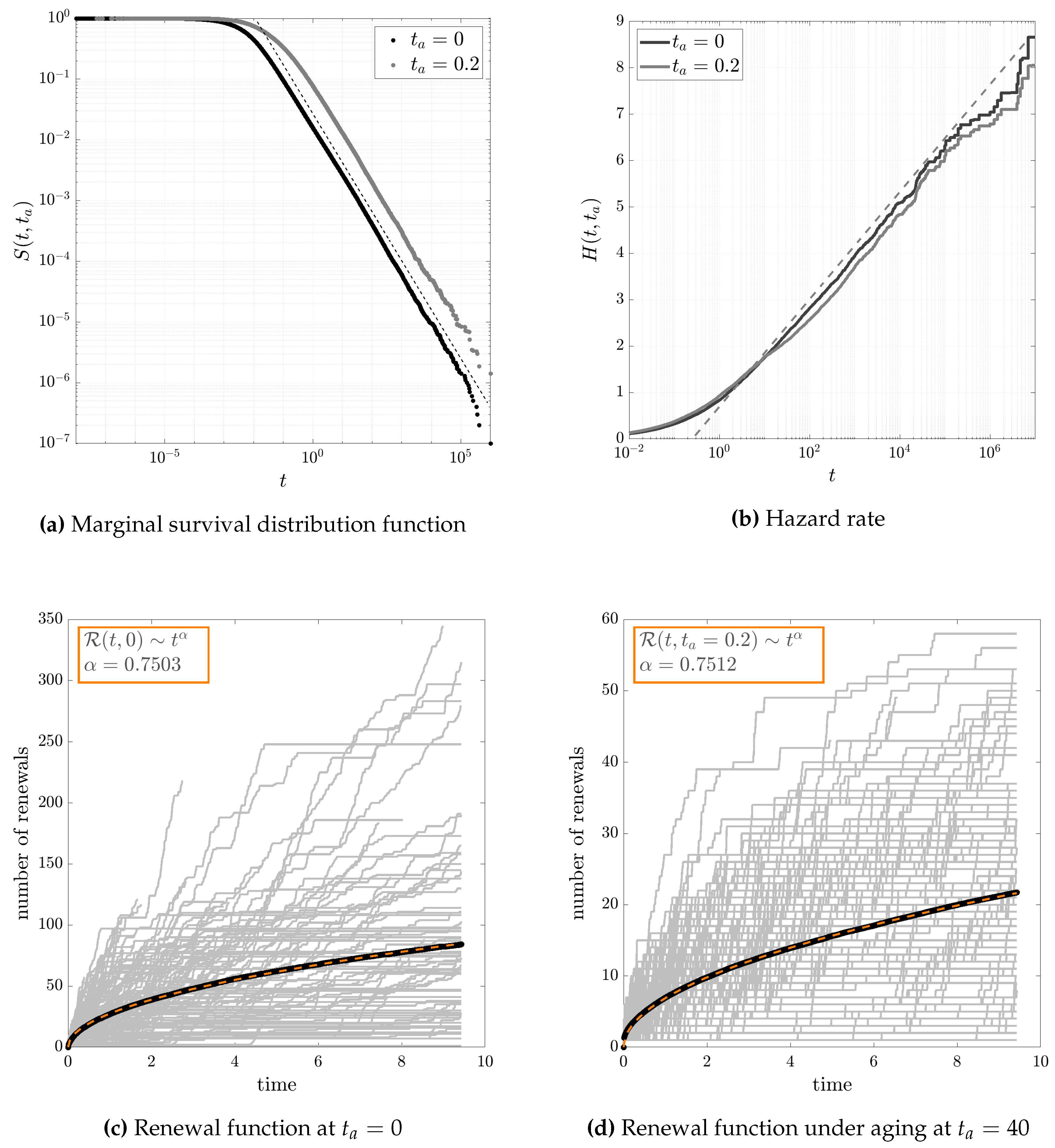
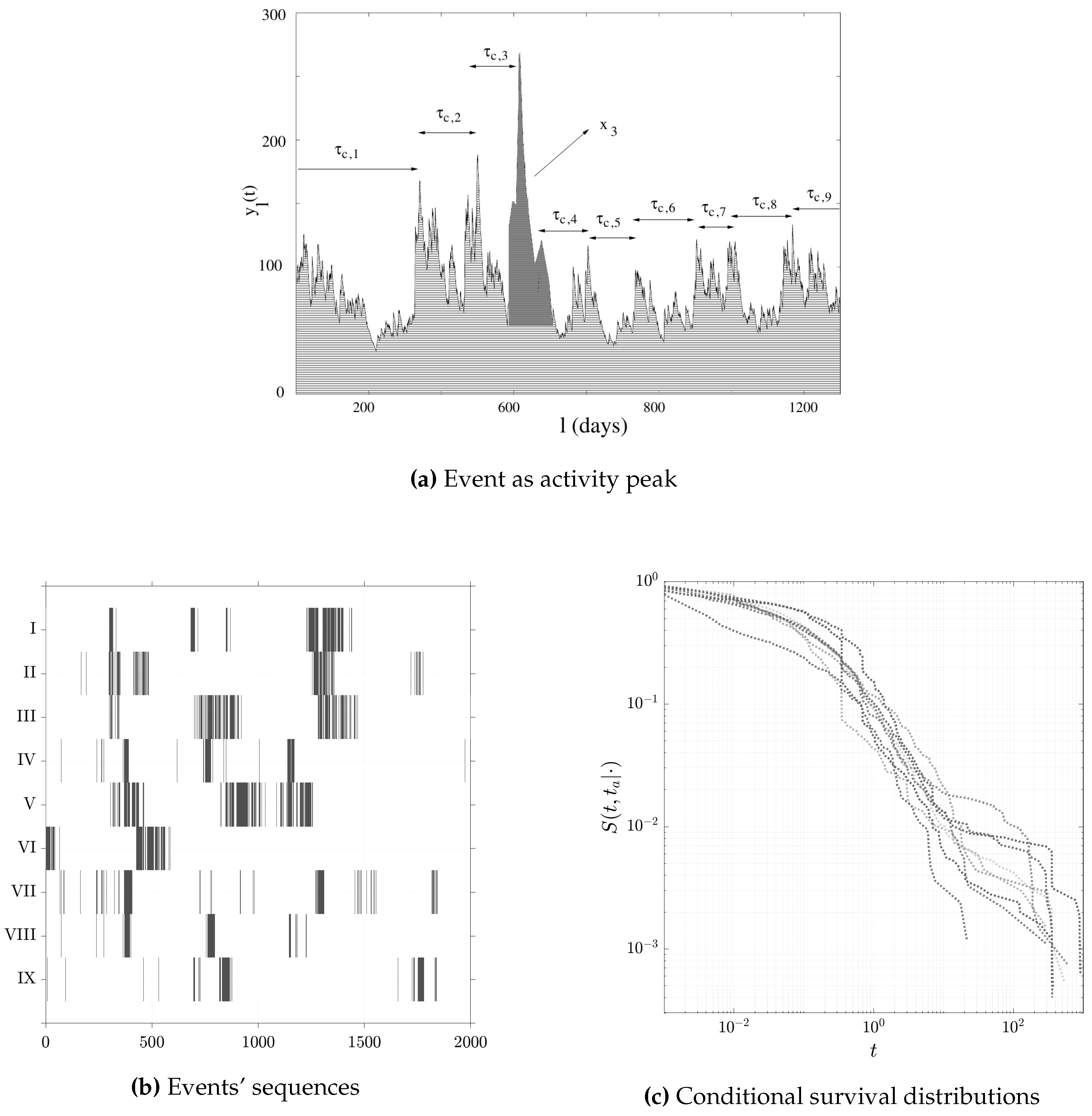
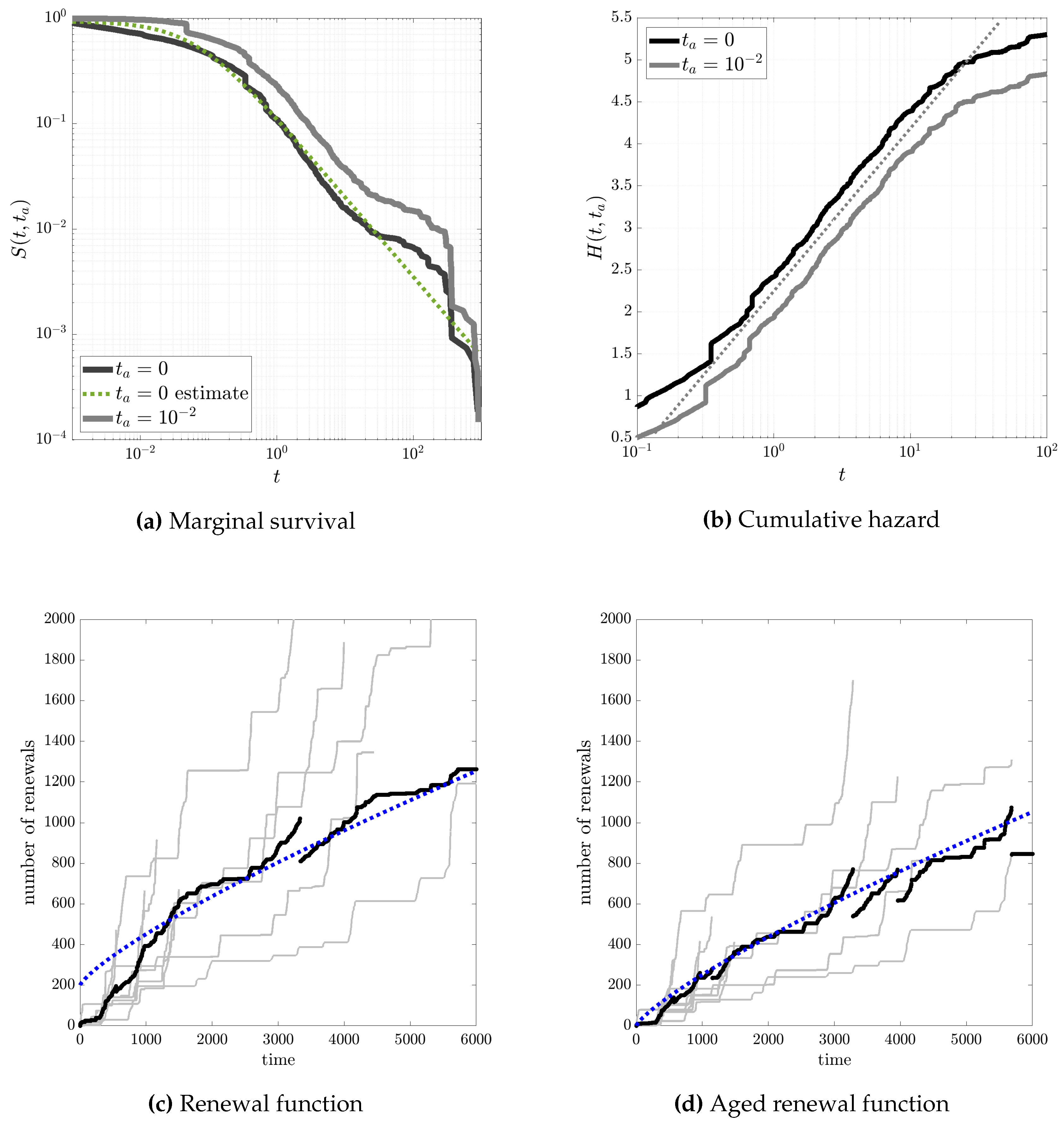
| code | Pair | Name |
|---|---|---|
| I | USD/EUR | US Dollar/Euro |
| II | USD/AUD | US Dollar/Australian Dollar |
| III | USD/GBP | US Dollar/British Pound |
| IV | USD/NZD | US Dollar/New Zealand Dollar |
| V | USD/CAD | US Dollar/Canadian Dollar |
| VI | USD/CHF | US Dollar/Swiss Franc |
| VII | USD/JPY | US Dollar/Japanese Yen |
| VIII | USD/MXN | US Dollar/Mexican Peso |
| IX | USD/ZAR | US Dollar/South African Rand |
Disclaimer/Publisher’s Note: The statements, opinions and data contained in all publications are solely those of the individual author(s) and contributor(s) and not of MDPI and/or the editor(s). MDPI and/or the editor(s) disclaim responsibility for any injury to people or property resulting from any ideas, methods, instructions or products referred to in the content. |
© 2024 by the authors. Licensee MDPI, Basel, Switzerland. This article is an open access article distributed under the terms and conditions of the Creative Commons Attribution (CC BY) license (https://creativecommons.org/licenses/by/4.0/).





